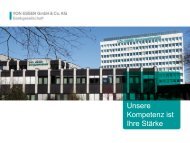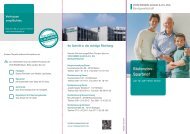2012 Registration document and annual financial report - BNP Paribas
2012 Registration document and annual financial report - BNP Paribas
2012 Registration document and annual financial report - BNP Paribas
- No tags were found...
Create successful ePaper yourself
Turn your PDF publications into a flip-book with our unique Google optimized e-Paper software.
4CONSOLIDATEDFINANCIAL STATEMENTS - YEAR ENDED 31 DECEMBER <strong>2012</strong>Notes to the <strong>financial</strong> statements41.d ACCOUNTING STANDARDS SPECIFIC TOINSURANCE BUSINESSThe specific accounting policies relating to assets <strong>and</strong> liabilities generatedby insurance contracts <strong>and</strong> <strong>financial</strong> contracts with a discretionaryparticipation feature written by fully consolidated insurance companiesare retained for the purposes of the consolidated <strong>financial</strong> statements.These policies comply with IFRS 4.All other insurance company assets <strong>and</strong> liabilities are accounted for usingthe policies applied to the Group’s assets <strong>and</strong> liabilities generally, <strong>and</strong>are included in the relevant balance sheet <strong>and</strong> profit <strong>and</strong> loss accountheadings in the consolidated <strong>financial</strong> statements.1.d.1AssetsFinancial assets <strong>and</strong> non-current assets are accounted for using thepolicies described elsewhere in this note. The only exceptions are sharesin civil property companies (SCIs) held in unit-linked insurance contractportfolios, which are measured at fair value on the balance sheet datewith changes in fair value taken to profit or loss.Financial assets representing technical provisions related to unit-linkedbusiness are shown in “Financial assets at fair value through profit orloss”, <strong>and</strong> are stated at the realisable value of the underlying assets atthe balance sheet date.1.d.2LiabilitiesThe Group’s obligations to policyholders <strong>and</strong> beneficiaries are shownin “Technical reserves of insurance companies” <strong>and</strong> are comprisedof liabilities relating to insurance contracts carrying a significantinsurance risk (e.g., mortality or disability) <strong>and</strong> to <strong>financial</strong> contractswith a discretionary participation feature, which are covered by IFRS 4.A discretionary participation feature is one which gives life policyholdersthe right to receive a share of actual profits as a supplement to guaranteedbenefits.Liabilities relating to other <strong>financial</strong> contracts, which are covered byIAS 39, are shown in “Due to customers”.Unit-linked contract liabilities are measured in reference to the fair valueof the underlying assets at the balance sheet date.The technical reserves of life insurance subsidiaries consist primarilyof mathematical reserves, which generally correspond to the surrendervalue of the contract.The benefits offered relate mainly to the risk of death (term life insurance,annuities, loan repayment, guaranteed minimum on unit-linked contracts)<strong>and</strong>, for borrowers’ insurance, to disability, incapacity <strong>and</strong> unemploymentrisks. These types of risks are controlled by the use of appropriatemortality tables (certified tables in the case of annuity-holders), medicalscreening appropriate to the level of benefit offered, statistical monitoringof insured populations, <strong>and</strong> reinsurance programmes.Non-life technical reserves include unearned premium reserves(corresponding to the portion of written premiums relating to futureperiods) <strong>and</strong> outst<strong>and</strong>ing claims reserves, inclusive of claims h<strong>and</strong>lingcosts.The adequacy of technical reserves is tested at the balance sheet date bycomparing them with the average value of future cash flows as derivedfrom stochastic analyses. Any adjustments to technical reserves are takento the profit <strong>and</strong> loss account for the period. A capitalisation reserveis set up in individual statutory accounts on the sale of amortisablesecurities in order to defer part of the net realised gain <strong>and</strong> hencemaintain the yield to maturity on the portfolio of admissible assets. In theconsolidated <strong>financial</strong> statements, the bulk of this reserve is reclassifiedto “Policyholders’ surplus” on the liabilities side of the consolidatedbalance sheet; a deferred tax liability is recognised on the portion takento shareholders’ equity.This item also includes the policyholders’ surplus reserve resultingfrom the application of shadow accounting. This represents the interestof policyholders, mainly within French life insurance subsidiaries, inunrealised gains <strong>and</strong> losses on assets where the benefit paid underthe policy is linked to the return on those assets. This interest is anaverage derived from stochastic analyses of unrealised gains <strong>and</strong> lossesattributable to policyholders in various scenarios.In the event of an unrealised loss on shadow accounted assets, apolicyholders’ loss reserve is recognised on the assets side of theconsolidated balance sheet in an amount equal to the probable deductionfrom the policyholders’ future profit share. The recoverability of thepolicyholders’ loss reserve is assessed prospectively, taking into accountpolicyholders’ surplus reserves recognised elsewhere, capital gainson <strong>financial</strong> assets that are not shadow accounted due to accountingelections made (held-to-maturity <strong>financial</strong> assets <strong>and</strong> propertyinvestments measured at cost) <strong>and</strong> the company’s ability <strong>and</strong> intentionto hold the assets carrying the unrealised loss. The policyholders’ lossreserve is recognised symmetrically with the corresponding assets<strong>and</strong> shown on the assets side of the balance sheet under the line item“Accrued income <strong>and</strong> other assets”.1.d.3Profit <strong>and</strong> loss accountIncome <strong>and</strong> expenses arising on insurance contracts written by the Groupare recognised in the profit <strong>and</strong> loss account under “Income from otheractivities” <strong>and</strong> “Expenses on other activities”.Other insurance company income <strong>and</strong> expenses are included in therelevant profit <strong>and</strong> loss account item. Consequently, movements in thepolicyholders’ surplus reserve are shown on the same line as gains <strong>and</strong>losses on the assets that generated the movements.1.e PROPERTY, PLANT, EQUIPMENT ANDINTANGIBLE ASSETSProperty, plant <strong>and</strong> equipment <strong>and</strong> intangible assets shown in theconsolidated balance sheet are composed of assets used in operations<strong>and</strong> investment property.Assets used in operations are those used in the provision of services orfor administrative purposes, <strong>and</strong> include non-property assets leased bythe Group as lessor under operating leases.120<strong>2012</strong> <strong>Registration</strong> <strong>document</strong> <strong>and</strong> <strong>annual</strong> <strong>financial</strong> <strong>report</strong> - <strong>BNP</strong> PARIBAS





